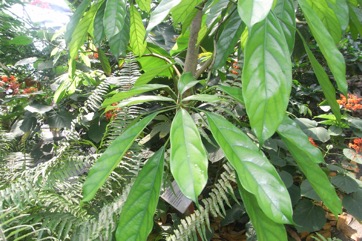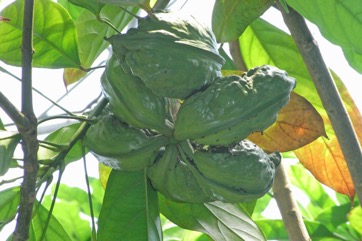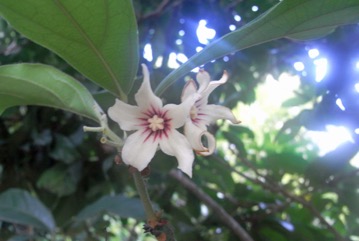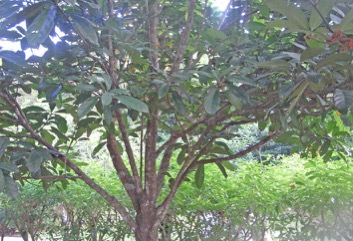Ghanja Kola, Bitter Cola

It is a tropical plant. It grows in lowland rain-forest. It needs a temperature above 20-24°C for planting and tolerate a temperature down to 13-15°C. It suits hardiness zones 11-12.
Also known as:
Ajauru, Bakuru, Buur, Cola, Coleira, Colo-fuque, Curo-djo-o, Curo, Evbe, Goeh, Goro, Mancuur, N'kola, Obi-akechi, Obi-gbanja, Oji igbo, Pohon kola nitida, Pohon kola pahit, Uncurame
Synonyms
- Sterculia nitida Vent.
- Cola acuminata (P. Beauv.) Sch. & Endl.
- Cola vera
Edible Portion
- Seeds, Fruit
Where does Ghanja Kola grow?
Found in: Africa, Asia, Australia, Benin, Burkina Faso, Cameroon, Central Africa, Congo DR, Congo R, Côte d'Ivoire, East Africa, Gabon, Ghana, Guinea, Guinée, Guinea-Bissau, India, Indochina, Indonesia, Ivory Coast, Liberia, Mozambique, Niger, Nigeria, SE Asia, Senegal, Sierra Leone, Singapore, Togo, Vietnam, West Africa
Notes: Also put in the family Sterculiaceae.
Status: It is a cultivated food plant.
Growing Ghanja Kola, Bitter Cola
Cultivation: Plants can be grown from seed or by cuttings. It can be grown by suckers.
Edible Uses: The nut is used as a masticatory. The nuts are also dried and sold. They are chewed as a caffeine rich stimulant. The seeds are dried, ground and made into drinks.
Nutrition Info
per 100g edible portion| Edible Part | Energy (kcal) | Protein (g) | Iron (mg) | Vitamin A (ug) | Vitamin c (mg) | Zinc (mg) | % Water |
|---|---|---|---|---|---|---|---|
| Nuts | 148 | 2.2 | 2 | - | - | - | 62.9 |
| Nuts dried | 351 | 5.8 | 6 | - | - | - | 11.5 |
Ghanja Kola, Bitter Cola Photos




References
Ambasta, S.P. (Ed.), 2000, The Useful Plants of India. CSIR India. p 136
Aniama, S. O., et al, 2016, Ethnobotanical documentaton of some plants among Igala people of Kogi State (Nigeria). The International Journal Of Engineering And Science (IJES). 5(4) pp 33-42
Assogbadjo, A. E. et al, 2013, Specific Richness and Cultural Importance of Wild Edible Trees in Benin. Acta Hort. 979, ISHS 2013
Atato, A., et al, 2010, Diversity of Edible Wild Fruit Tree Species of Togo. Global Science Books.
Bernholt, H. et al, 2009, Plant species richness and diversity in urban and peri-urban gardens of Niamey, Niger. Agroforestry Systems 77:159-179
Bremness, L., 1994, Herbs. Collins Eyewitness Handbooks. Harper Collins. p 50
Brouk, B., 1975, Plants Consumed by Man. Academic Press, London. p 348, 377
Brown, D., 2002, The Royal Horticultural Society encyclopedia of Herbs and their uses. DK Books. p 175
Burkill, H. M., 1985, The useful plants of west tropical Africa, Vol. 5. Kew.
Burkill, I.H., 1966, A Dictionary of the Economic Products of the Malay Peninsula. Ministry of Agriculture and Cooperatives, Kuala Lumpur, Malaysia. Vol 1 (A-H) p 641
Catarino, L., et al, 2016, Ecological data in support of an analysis of Guinea-Bissau's medicinal flora. Data in Brief 7 (2016):1078-1097
Cobley, L.S. (rev. Steele, W.M.) 2nd Ed., 1976, An Introduction to the Botany of Tropical Crops. Longmans. p 216
Codjia, J. T. C., et al, 2003, Diversity and local valorisation of vegetal edible products in Benin. Cahiers Agricultures 12:1-12
Dalziel, J. M., 1937, The Useful plants of west tropical Africa. Crown Agents for the Colonies London.
Dibong, S. D., et al, 2011, Inventory and Biodiversity of species edible wild fruits sold in the markets of Douala, Cameroon. International Journal of Applied Biology and Pharmaceutical Technology. 2(3).
Eijnatten van, C.L.M., 1979, Kola, in Simmonds, N.W., (ed), Crop Plant Evolution. Longmans. London. p 284
Etherington, K., & Imwold, D., (Eds), 2001, Botanica's Trees & Shrubs. The illustrated A-Z of over 8500 trees and shrubs. Random House, Australia. p 220
Facciola, S., 1998, Cornucopia 2: a Source Book of Edible Plants. Kampong Publications, p 239
Grivetti, L. E., 1980, Agricultural development: present and potential role of edible wild plants. Part 2: Sub-Saharan Africa, Report to the Department of State Agency for International Development. p 30, 33
Hawthorne, W.& Marshall, C., 2013, Nimba Western Area Iron Ore Concentrator Mining Project Environmental and Social Impact Assessment. AcelorMittel Liberia. p 469
Heywood, V.H., Brummitt, R.K., Culham, A., and Seberg, O., 2007, Flowering Plant Families of the World. Royal Botanical Gardens, Kew. p 311
Jardin, C., 1970, List of Foods Used In Africa, FAO Nutrition Information Document Series No 2.p 33
Keay, R.W.J., 1989, Trees of Nigeria. Clarendon Press, Oxford. p 136
Kiple, K.F. & Ornelas, K.C., (eds), 2000, The Cambridge World History of Food. CUP p 1797
Kuhnlein, H. V., et al, 2009, Indigenous Peoples' food systems. FAO Rome p 260
liberianfaunaflora.org Plant Atlas
Manvell, A., 2011, Use of Non-Timber Forest Products around Sapo National Park, Liberia (Report B) p 51
Melet. bot. 33. 1832
Menninger, E.A., 1977, Edible Nuts of the World. Horticultural Books. Florida p 40
Moutsambote, J., 1996, Vegetation forestiere et plantes alimentaires de la region de la Sangha. Chp. 11 of Bien Manger et Bien Vivre. ORSTOM p 119
Nkeoua, G. & Boundzanga, G. C., 1999, Donnees sur les produits forestieres non ligneux en Republique du Congo. FAO. p 22
Odebunmi, E., Oluwaniyi, O., Awoloa, G., et al., 2009, Proximate and Nutritional Composition of Kola Nut (Cola nitida), Bitter Cola (Garcinia cola) and Alligator Pepper (Afromomum melegueta). African Journal of Biotechnology, 8, 308-309.
Peters, C. R., O'Brien, E. M., and Drummond, R.B., 1992, Edible Wild plants of Sub-saharan Africa. Kew. p 188
Pham-Hoang Ho, 1999, An Illustrated Flora of Vietnam. Nha Xuat Ban Tre. p 511
PROSEA (Plant Resources of South East Asia) handbook, Volume 16, 2000, Stimulants.
Purseglove, J.W., 1968, Tropical Crops Dicotyledons, Longmans. p 566
Russell, T.A., 1955, Tropical Agriculture 32
Savill, P. S. & Fox, J. E. D., Trees of Sierra Leone. p 252
Small, E., 2009, Top 100 Food Plants. The world's most important culinary crops. NRC Research Press. p 219
Sukarya, D. G., (Ed.) 2013, 3,500 Plant Species of the Botanic Gardens of Indonesia. LIPI p 207
van Wyk, B., 2005, Food Plants of the World. An illustrated guide. Timber press. p 149
Vickery, M.L. and Vickery, B., 1979, Plant Products of Tropical Africa, Macmillan. p 90
Vivien, J., & Faure, J.J., 1996, Fruitiers Sauvages d'Afrique. Especes du Cameroun. CTA p 342
Wickens, G.E., 1995, Edible Nuts. FAO Non-wood forest products. FAO, Rome. p 84, 155
World Checklist of Useful Plant Species 2020. Royal Botanic Gardens, Kew
www.worldagroforestrycentre.org/treedb/